New species of carnivorous land snail discovered in Kolhapur Sahyadri
Category : Wildlife |
Location : Maharashtra | Posted on 2022-06-24 00:28:21

- Mumbai: While his father helms the state government and elder brother handles the state’s environment ministry, Tejas Thackeray has been quietly making waves in the world of zoology and wildlife conservation. The 26-year-old son of Uddhav Thackeray, who helms the Thackeray Wildlife Foundation, has contributed to a number of new scientific discoveries, the latest of which is the discovery of a new species of carnivorous land snail from the Vishalgad Conservation Reserve, Kolhapur. The discovery by the researchers, including Thackeray and his colleagues Amrut Bhosale and Omkar Yadav, was made in a relatively unexplored region of the Sahyadri range amid the northern Western Ghats. The location was declared a protected area under the Wildlife Act in March 2021.
- Experts said that the discovery of this new faunal species, findings of which was published earlier this month, validates the state government’s decision to declare the region as a Conservation Reserve. The move was first proposed by the state board for wildlife (SBWL) in December 2020. The finding is significant, experts said, because land snails are considered bio-indicators and point to the larger health of the ecosystems they habitat.
- The new species – christened Haploptychius sahyadriensis after the habitat it was discovered in – belongs to a larger family of air-breathing land snails called ‘streptaxidae’, and is the first record of the genus Haploptychius from mainland India (two species have been previously described from the Andaman & Nicobar Islands). It can be distinguished from other Haploptychius species, found across southeast Asia, by its unique reproductive system.
- “This is the third species of carnivorous land snail to be described from the Sahyadris in the span of less than a year. This shows how poorly studied and explored the ghats are. What we know is just the tip of the iceberg. Understanding the diversity amongst these molluscs is extremely critical along with mapping out their distribution patterns as they all seem to be endemic and specialised habitat dwellers,” said Tejas Thackeray.
- “Slightest of changes to their environment and they could be lost forever and since they’re highly dependent on the monsoons, erratic weather patterns triggered by global warming could affect them the quickest. The discovery comes from a newly declared conservation reserve, I hope all governments look beyond just tigers and elephants and place these tiny neglected species high on their priority lists just like the Maharashtra government has,” he added.
- Haploptychius sahyadriensis is the third variant of carnivorous land snail to have been discovered in the Sahyadris, the other two belonging to the genus Perrottetia, were first described in 2021. It is the latest addition to a rich diversity of endemic land snails in the Western Ghats.
- Land snails are ‘detritivores’, feeding on dead organic material, adding fertility to the soil and maintaining its chemical and physical properties through fecal discharge, which contains uric acid derived from nitrogen. Snail feces also promote the growth of important fungi. “They are an essential part of the food chain. Their shells and other body parts contain calcium, making them an important source of nutrition for nesting female birds, who require calcium to produce eggshells,” said Amrut Bhosale, zoologist and one of the researchers behind this discovery.
- “Our findings are the first time that someone has described a new species from Vishalgad CR, and it validates the state government’s decision to bring the area under protection. It is a positive step for biodiversity. This study will give impetus for more faunal surveys in the northern western ghats, which are relatively understudied as compared to the central and southern ranges,” Bhosale added.
- Researchers also explained that India harbours about 5% of the world’s malaco-faunal biodiversity (relating to mollusks, which include animals like snails, clams, oysters and octopi) and that nearly 50% of this group are endemic to various parts of India, with very small geographic ranges, making it all the more important to understand their specific function in the environment and protect them
- Notably, the discovery of the Haploptychius sahyadriensis in Vishalgad is part of a larger project by the same researchers, in which they are conducting an extensive land-snail survey in the Sahyadris and adjacent forests, across a total of 1,56,761 hectares of land, including various wildlife sanctuaries and conservation reserves in Maharashtra.
- Since 2016, Tejas Thackeray has published at least 24 academic works, most of them dealing with the description of new species of crabs, fish, birds, snakes, geckos and snails, with a particular focus on the biodiversity of the Western Ghats in Maharashtra. In September 2021, a new species of swamp eel was discovered from a well in Mumbai by Tejas Thackeray and the team at Thackeray Wildlife Foundation.
- Source: https://www.hindustantimes.com/cities/mumbai-news/new-species-of-carnivorous-land-snail-discovered-in-kolhapur-sahyadri-101655665006399.html
